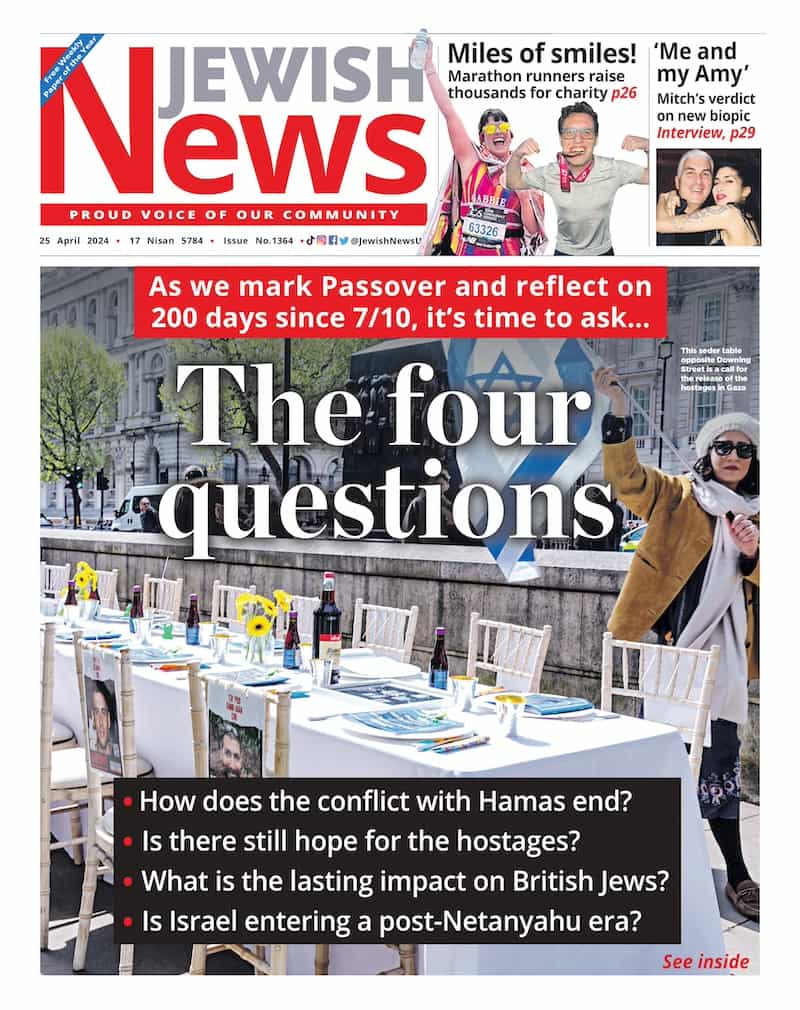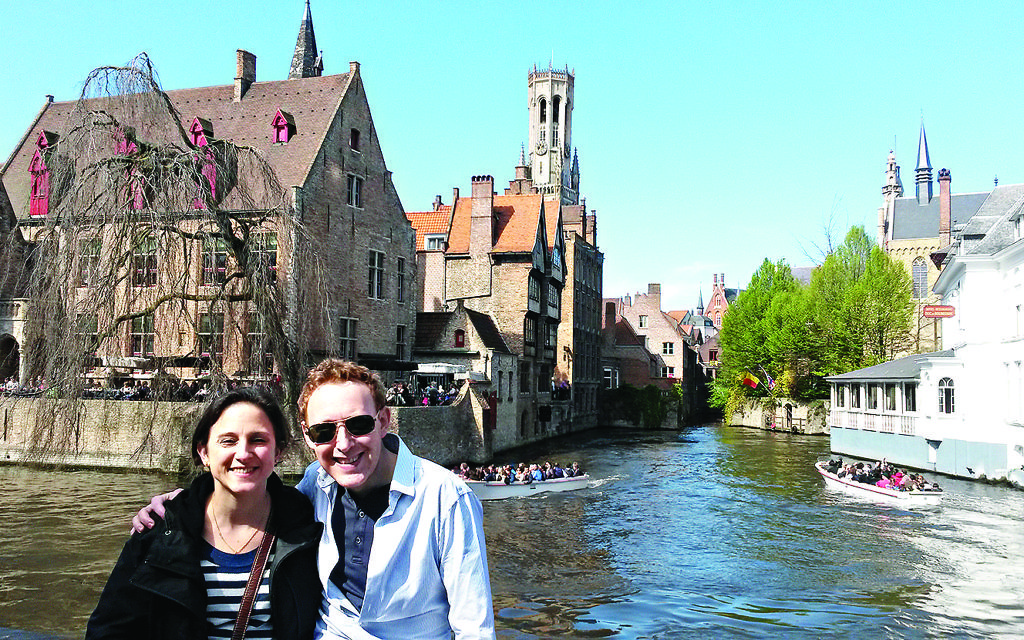It’s Jewish culture 1 Chocolate shops 50 in beautiful Bruges
Like a child eagerly awaiting a long-promised visit to Disneyland, I had for years been mentally savouring a visit to Bruges. The capital of the West Flanders province did not disappoint. My husband, Michael, and I excitedly boarded the Eurostar to Brussels Midi. Travelling by standard premier, which offered plenty of room and a light lunch, we arrived in Brussels in just two hours. We then took the regional (double decker) train to Bruges, about an hour’s journey.
Arriving in Bruges, we felt we had stepped back in time; the taxi seeming far too clunky for the narrow cobbled streets of the city, a former trading market of medieval Europe.
Get The Jewish News Daily Edition by email and never miss our top stories Free Sign Up
Our hotel, the three-star Martin’s Brugge, situated behind the Market Square and right in the heart of the historic city centre – which is recognised by UNESCO as a world heritage site – was more than adequate as a base for a three-day exploration of the streets lined with around 50 chocolate boutiques, all jostling for the euro of the four million tourists who visit Bruges per year. The hotel has 177 bedrooms, which are categorised into four types, and offers a happy hour at its bar.
On our first full day, we took a whistle-stop boat trip through what our guide called the ‘veins of Brugges’, admiring the Belfry, an 83-metre tall medieva tower with 366 steps and 47 bells that gives superb panoramic views over the city, several bridges dating back to the 13th Century. However, the “most beautiful” one is, according to our guide, the Bonifacius bridge, which was built in the 20th Century.
We passed by the almshouses built by the rich to house the elderly, and Jan van Eyckplein, the square with the statue of the famous 15th Century Flemish painter, one of the most important of the Flemish Primitive artists, whose work is displayed in the Groeninge Museum along with other Flemish masters, including Hugo van der Goes and Hans Memling. We were pointed out the Vlissinghe, the city’s oldest inn dating back to 1515, where we later had a drink in its delightful garden.
Then we passed by Burghers Lodge, with its statue of a bear – the mascot of the city and of FC Brugges – the 18th Century Vismarkt, or fish market, where fresh fish is still sold every Tuesday to Saturday morning and where we later saw stalls selling arts and crafts.
We saw the Church of Our Lady, home to Michelangelo’s world-famous marble Madonna with Child sculpture. We made a mental note to revisit the Beguinage, home to the lay religious sisterhood that became a monastery in 1927 and is still occupied by Benedictine sisters, and Minnewater, a beautiful canalised lake that is also known as the Lake of Love, the grass verges of which are populated by swans – one of the symbols of Bruges
. Although we could have taken a tour of the city by horse and carriage ride – to truly immerse ourselves in the historical ambiance – or hired bicycles, we preferred to lose ourselves on foot through the city’s winding streets. We passed through the Burg, one of the city’s most beautiful squares where there is a real mix of architectural styles, from the Romanesque Saint Basil’s Church to
the Gothic and imposing 14th Century City Hall.
We stopped to take pictures at the Rozenhoedkaai, where the Belfry joins the city’s canals and is considered one of the city’s most photographed romantic spots. We strolled through the old Hanseatic neighbourhood and just about managed to stop ourselves sampling treats in every chocolate shop we visited.
Before our visit, I had tried very hard to find anything of Jewish interest in the city, to be told by various sources there was none. Just as I had lost all hope of finding one, there, in the Museum-Gallery Xpo Salvador Dali located inside the Belfry and practically winking at me, was a menorah made by the surrealist Spanish artist. Seeing my interest, the sales assistant (for the museum also sells Dali’s original art, sculpture and drawings) reminded me a larger one, known as the Peace Menorah, is located outside Ben Gurion airport in Tel Aviv and showed me other pieces from Dali’s ‘Jewish period’.
There are many other attractions that we did not manage to see, including the Bruges Diamond Museum, which relays the history of the city as the oldest diamond centre in Europe, Choco-Story, the world’s largest chocolate museum and the Lace Centre, which gives demonstrations of another of Belgium’s famous exports.
There is the Sint-Janshospitaal Museum (formerly the city’s largest institution for the sick and poor, which is now a museum and is famed for its masterpieces by Memling), the Belgian Fries Museum (yes, really!) and a Picasso exhibition that also features works by his friends, including Chagall and Matisse.
Bruges does, of course, serve food other than chocolate. There are plenty of award-winning restaurants, including Michelin-starred ones, but we opted for the cosy ambiance of the neighbourhood cafes and pubs, where we could watch the well-heeled tourists and locals to our heart’s content.
We made sure to sample the local fare. My husband enjoyed a typical Flemish beef stew (“mouth-watering”), while I tried the white asparagus, Flemis
h style, with eggs and a butter sauce, and we shared the obligatory chips – on more than one occasion. We tried marinated anchovies (like Mrs Elswood’s rollmops) and soaked up the sun with a waffle and Chantilly cream in the Steenstraat, one of the two main shopping areas.
A trip to Belgium is not complete without tasting the beer. Michael duly ordered Brugse Zot, one of three local beers and the only one brewed in the town centre. He was disappointed by Tongerlo but declared his favourite to be IPA Vedett, which had been recommended by the barman at De Republiek, a café/bar with an arresting vibe.
For beer lovers, a visit to De Halve Maan (the Half Moon) (Straffe Hendrik) brewery is recommended. Dating back to 1856, it describes itself as the only family brewery still active in the centre of Bruges. We tried to have a cheeky aperitif at 2be, a small bar with a patio beside the canal and a beer wall showcasing more than 1,000 Belgian beers; sadly it was closed for a private party.
Bruges truly is chocolate-box pretty; an architecturally significant city with resplendent buildings, it lives up to its title of the Venice of the North.
And speaking of magnificent buildings, on our last night, we stayed at the beautiful Die Swaene, a four-star hotel in buildings dating from the 15th and 18th Centuries (it was originally made up of two private houses) that is a member of the Small Luxury Hotels of the World™.
Our luxury-sized room – along with seven other bedrooms – was in the pergola, which gives over the canal, a serene and relaxing vista. Michael took in a short stop in the sauna (there is also a swimming pool) and in the morning we enjoyed an exquisite breakfast in the main building (home to another 16 bedrooms).
As well as the usual continental offerings, breakfast included baked apples topped with flaked almonds, cakes and chocolates (chocolate! for breakfast! Well, Bruges is not called the world’s capital of chocolate for nothing).
Reader, I tried, but I could not resist.
Pay attention,” my husband said. “This is how you’re going to serve me breakfast every morning!” It was a fittingly sweet end to a beautiful weekend.
Useful Contacts
• Eurostar’s ‘Any Belgian station’ fares start from £79 return; this includes travel on local trains to Bruges, www.eurostar.com
• Buy the ‘Bruges City Card’, which lets you visit many important tourist sites for free or at reduced cost www.bruggecitycard.be/index _en.html
• Rooms at Martin’s Brugge start from 99 euro including breakfast on a weekday, www.martins hotels.com/en/hotel/martins-brugge
• Rooms at Die Swaene, Bruges, with Small Luxury Hotels of the World™ (SLH) start from £160 per night including breakfast, based on two people sharing. www.slh.com / 0800 0482 314 • Museum-Gallery XPO Salvador Dali – www.dali-interart.be/engl_events.htm • Visit Bruges – http://visitbruges.be

Thank you for helping to make Jewish News the leading source of news and opinion for the UK Jewish community. Today we're asking for your invaluable help to continue putting our community first in everything we do.
For as little as £5 a month you can help sustain the vital work we do in celebrating and standing up for Jewish life in Britain.
Jewish News holds our community together and keeps us connected. Like a synagogue, it’s where people turn to feel part of something bigger. It also proudly shows the rest of Britain the vibrancy and rich culture of modern Jewish life.
You can make a quick and easy one-off or monthly contribution of £5, £10, £20 or any other sum you’re comfortable with.
100% of your donation will help us continue celebrating our community, in all its dynamic diversity...
Engaging
Being a community platform means so much more than producing a newspaper and website. One of our proudest roles is media partnering with our invaluable charities to amplify the outstanding work they do to help us all.
Celebrating
There’s no shortage of oys in the world but Jewish News takes every opportunity to celebrate the joys too, through projects like Night of Heroes, 40 Under 40 and other compelling countdowns that make the community kvell with pride.
Pioneering
In the first collaboration between media outlets from different faiths, Jewish News worked with British Muslim TV and Church Times to produce a list of young activists leading the way on interfaith understanding.
Campaigning
Royal Mail issued a stamp honouring Holocaust hero Sir Nicholas Winton after a Jewish News campaign attracted more than 100,000 backers. Jewish Newsalso produces special editions of the paper highlighting pressing issues including mental health and Holocaust remembrance.
Easy access
In an age when news is readily accessible, Jewish News provides high-quality content free online and offline, removing any financial barriers to connecting people.
Voice of our community to wider society
The Jewish News team regularly appears on TV, radio and on the pages of the national press to comment on stories about the Jewish community. Easy access to the paper on the streets of London also means Jewish News provides an invaluable window into the community for the country at large.
We hope you agree all this is worth preserving.
-
By Brigit Grant
-
By Laurent Vaughan - Senior Associate (Bishop & Sewell Solicitors)
-
By Laurent Vaughan - Senior Associate (Bishop & Sewell Solicitors)
-
By Laurent Vaughan - Senior Associate (Bishop & Sewell Solicitors)
-
By Laurent Vaughan - Senior Associate (Bishop & Sewell Solicitors)

























